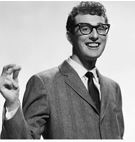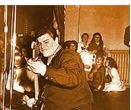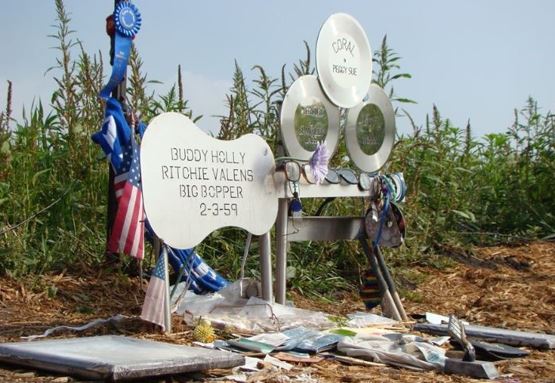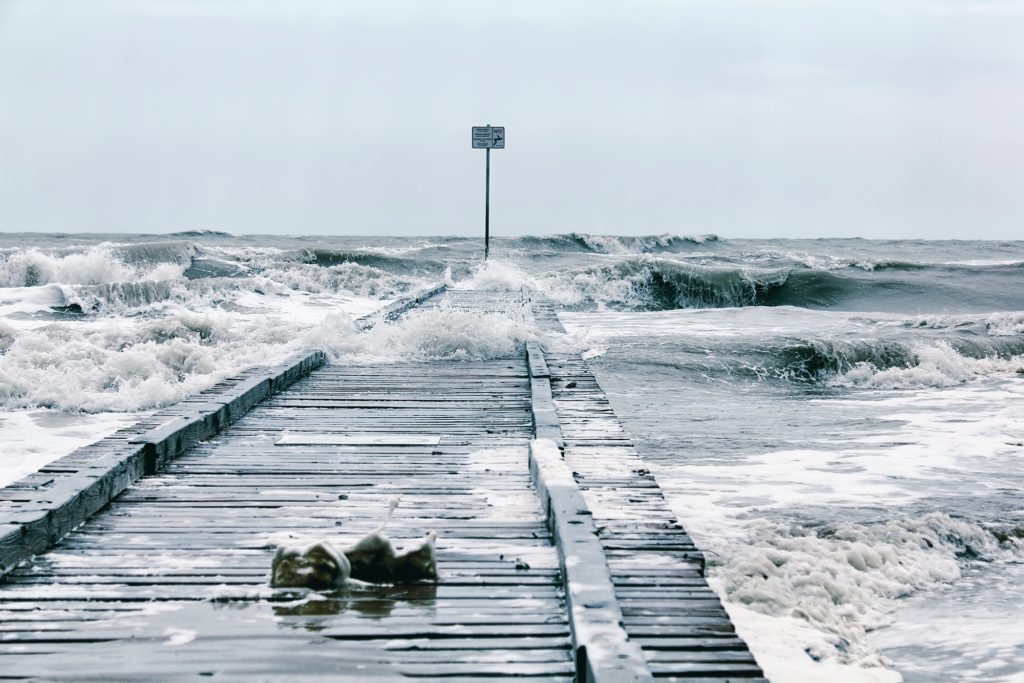A long, long time ago, sixty six years to be exact, a Beechcraft Bonanza aircraft took off from a small airport in Mason City Iowa on a snowy and frigid February night. With a pilot and three famous passengers onboard, the plane disappeared from the sky after a few minutes and so did a piece of popular music history.
An Ill-Fated Tour
In only a year and a half, twenty-two-year-old Buddy Holly has become famous as a musician and vocalist. With his band the Crickets, they produced popular hit songs like “Peggy Sue” and “That’ll Be The Day”. Buddy Holly left the Crickets in late 1958.
A photo of Buddy Holly in 1958. Photo Credit: Wikipedia-Public Domain.
Richie Valens was riding the rails of popularity with his smash hit “La Bamba” despite the fact that he was just seventeen years old.
J.P. “The Big Bopper” Richardson was a 28-year-old old singer that became famous with the song “Chantilly Lace”.
It was early in 1959 when these three musicians were joined together in what was an ill-fated tour from the beginning.
As 1959 began a group of music promoters, along with General Artists Corporation, hatched the idea of a “Winter Party Dance Tour” where popular singers and musicians would travel around a region. By then, Buddy Holly had assembled a new band with Waylon Jennings (bass), Tommy Allsup (guitar), Carl Bunch (drums) and Frankie Sardo with opening vocals.
Richie Valens, who had dropped out of high school, and “The Big Bopper”, plus Dion and The Belmont rounded out the tour.
A photo of Richie Valens in 1959 shortly before the crash. Photo Credit- Pinterest.
The tour would begin on January 23rd and end on end on February 15th. The first tour stop was Milwaukee, Wisconsin and things went rapidly downhill thereafter.
It seemed like everything about the tour was just plain bad. The progression of tour stops made no logical sense. They traveled all over the place, often back and forth, passing towns where they had already performed.
A photo of J.P. “The Big Bopper” Richardson performing in 1958- Public Domain.
The buses used for the tour were substandard, to say the least. Several were old school buses that constantly broke down and weren’t heated enough to deal with the bitterly cold temperatures during that period.
Several of the performers became ill. Drummer Carl Bunch had to leave the tour due to severely frostbitten feet.
The venues were also substandard. Many were small and they became crowded in a hurry. Several of them only had one microphone and horrible sound systems. After ten days, the performers were ready to call it quits.
On February 2nd the tour stop was in Clear Lake Iowa at the Surf Ballroom. A day earlier, their bus broke down on the way to the stop in Green Bay, Wisconsin. Their driver arrived on another bus to take the group to Clear Lake, which was a 360-mile drive. That bus broke down on the way and the musicians arrived in Clear Lake in a horrible mood.
Clear Lake, Iowa, was not originally a scheduled stop on the tour. Promoters wanted to fill an open date, so they contacted called manager of the Surf Ballroom, Carroll Anderson, and offered him the show. The next night, the group was scheduled to perform at the Moorhead, Minnesota, Armory.
Buddy Holly, who was at wits end, decided to charter an aircraft that would fly to Fargo, North Dakota, just across the border from Moorhead. Buddy spoke with Carroll Anderson about doing that and Anderson called Jerry Dwyer, who owned a local flight service to arrange the flight. It was yet to be decided was who would ride in the plane and who would proceed to Moorhead on the bus.
The evening show went on as scheduled in Clear Lake on February 2nd. Weather conditions were very cold with bitter winds and snow would be moving in overnight. The concert ended around midnight with Richie Valens singing “La Bamba”
A photo of an admission ticket to the final performance of Buddy Holly, “The Big Bopper” and Richie Valens in Clear Lake, Iowa on February 2, 1959 -Public Domain.
After the concert, transportation arrangements still needed to be worked out among the group. The aircraft could accommodate a pilot and three passengers. With a pilot and Buddy Holly, there was room for two more, There are variations of this story so I will present the most common one.
Tragedy Within Minutes
According to the most popular version of the story, Waylon Jennings was supposed to be a third passenger. “The Big Bopper” was tired of being cramped in bus seats every night, and he was feeling a bit under the weather. He asked Waylon to switch places with him. Tommy Alsup was supposed to be passenger number four. Riche Valens asked Allsup for his seat on the plane but Allsup didn’t want to give it up. They ended up flipping a coin and Richie Valens won. Each passenger was charged $36 for the flight.
According to the book Waylon: An Autobiography, Buddy Holly learned that his friend Waylon Jennings was not going to fly, he said teasingly “Well, I hope your bus freezes up.” Jennings responded: “Well, I hope your plane crashes”. That ill-fated response continues to haunt Waylon Jennings who became a famous performer in the years that followed.
Carroll Anderson drove the three passengers to the local airport. Roger Peterson, who was just 21 years old was a commercial pilot and fight instructor for Dwyer Flying Services. He would be the pilot on this flight. Peterson had plenty of experience as a pilot but he was not certified to fly solely by instruments, nor was the flight service licensed to fly unless visual flight rules were in effect.
 A photo of a V-tailed Bonanza similar to N3794N, the accident aircraft. Photo Credit- Wikipedia-Public Domain.
A photo of a V-tailed Bonanza similar to N3794N, the accident aircraft. Photo Credit- Wikipedia-Public Domain.
Peterson went to the Air Traffic Communications Station (ATCS), which was located in a tower on top of the Administration Building, for a weather briefing but the information given to him was missing key ingredients and not totally accurate. The briefing included current weather conditions at Mason City, Iowa; Minneapolis, Redwood Falls, and Alexandria, Minnesota and the terminal forecast for Fargo, North Dakota.
Peterson was advised that all these stations were reporting ceilings of 5,000 feet or better and visibility of 10 miles or above. In addition, the Fargo, North Dakota terminal forecast indicated the possibility of light snow showers after a cold frontal passage.
In reality, snow was moving quickly into the area, ceilings were at 3,000 feet and dropping. The temperature was 15 degrees and winds were gusting to over 30 mph. The approaching cold front was coming in much faster than it was communicated to Peterson at the briefing.
The aircraft took off at 12:55 a.m. on February 3rd, 1959. Jerry Dwyer was on a platform next to the tower observing the event. A normal takeoff was made and the aircraft was observed to make a left 180-degree turn and climb to approximately 800 feet and then, after passing the airport to the east, to head in a northwesterly direction. The tail light of the aircraft was plainly visible to Dwyer until it disappeared.
Around 1:00 am, when Peterson failed to make the expected radio contact, repeated attempts to establish communication were made, at Dwyer’s request, by the radio operator, but they were all unsuccessful.
Dwyer took off in another plane the next morning and observed a crashed aircraft in a corn field about 6 miles from the airport. A bit later, the body of the pilot was found inside the plane and the others were ejected from the plane.
Beyond The Doomed Flight
Buddy Holly’s pregnant wife, Maria Elena, learned of his death from a television report. She suffered a miscarriage shortly after the crash. Holly’s mother, on hearing the news screamed and collapsed after hearing of the crash on the radio.
Surprisingly, the “Winter Dance Party Tour” continued, as scheduled, the next night in Moorhead, Minnesota with Waylon Jennings replacing Buddy Holly on lead vocals. A local singer, 15-year old Robert Velline also performed with a couple of high school classmates. Velline later became famous as “Bobby Vee”.
A CAB (Civil Aeronautics Board ) investigation into the crash ensued. There was no indication of any mechanical defect on the plane. Due to poor weather conditions, a “visual” flight would have been impossible because of the low ceiling, the lack of a visible horizon, and the absence of ground lights in a rural area. Gusty winds and turbulence could have affected the rate of climb indicator.
The CAB concluded that the accident was due to “the pilot’s unwise decision” to embark on a flight that required instrument flying skills he had not proved to have. A contributing factor was Peterson’s unfamiliarity with the old-style attitude gyroscope on board the aircraft, which may have caused him to believe that he was climbing when he was in fact descending.
It seems to me that the pilot was completely overwhelmed by the environmental situation and he became confused and disoriented. Reading this made me think of a similar situation that resulted in the death of John F. Kennedy Jr. four decades later.
Jerry Dwyer and the company prevailed against a $1.5 million lawsuit, mainly because of insufficient weather information that was given to the pilot.
Dwyer said of the whole ordeal “It was the worst thing that ever happened in my life,” “until I lost my oldest son.”
In 2015 there was a movement to reopen the investigation of the crash but a formal request was denied by the NTSB (National Transportation Safety Board).
In 1971, singer/songwriter Don McLean released a song “American Pie” which rose to number 1 on the Billboard 200 chart. The song makes a reference to Buddy Holly, “The Big Bopper” and Richie Valens with the lyric “the day the music died”.
This photo shows a small memorial site where the plane crash that killed Buddy Holly occurred on February 3, 1959. Photo Credit- traveliowa.com.
Today, there is a half-mile path leading to a small memorial, where the plane came to rest following the final concert of Buddy Holly, J.P. “The Big Bopper” Richardson and Ritchie Valens.







